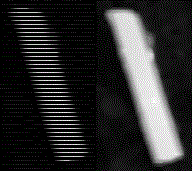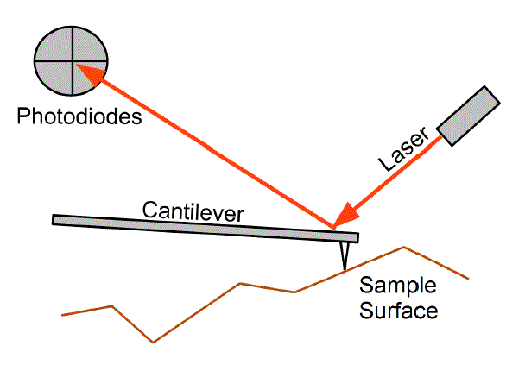The following is a synopsis of a talk that Alex Chen, second year postdoctoral fellow at SAMSI, recently gave at the postdoc seminar.
On January 23, I gave a talk in the postdoctoral seminar on “Image Reconstruction Methods for Atomic Force Microscopy,” in collaboration with members of my research group at UCLA and Lawrence Berkeley National Laboratory. Imaging by atomic force microscopes (AFMs) is gaining prominence in recent years as an alternative to light and electron microscopes. The basic principle in AFMs is that they scan the surface of a sample with a cantilever. A laser is shone onto the top of the cantilever, and force interactions between the cantilever and the sample lead to minute deflections in the laser. These deflections are then detected by photodiodes, and an accurate topographical map of the sample surface is obtained.
By relying on force deflections for imaging rather than reflected light, AFMs are able to resolve images up to the sub-nanometer scale, many times better than the optical diffraction limit. In addition, they do not require special treatments or special conditions for operation (such as a vacuum). Thus, dynamic processes and living organisms may be studied.
One particular challenge with AFMs, however, is that they obtain images at a slower rate than other forms of microscopy, somewhat negating their ability to image dynamic processes. There are various other mechanical difficulties: for example, temperature differences in the sample, AFM, and environment can lead to slight inaccuracies, known as thermal drift, in the topographical map.
Researchers have generally focused on improvements to hardware in order to increase imaging speed. Recently, however, there has been increased attention on “non-raster” scan paths, the idea that instead of visiting every point, it is sufficient only to visit the points containing interesting details. Missing portions of the collected data can be completed using image reconstruction techniques known as “inpainting” with the idea that a high degree of accuracy in the inpainted regions is not necessary.

Left: An InP nanowire obtained by AFM imaging. Only every 4th line is kept, in an attempt to speed up the imaging process. Right: The reconstructed image using the “total variation inpainting” algorithm
Furthermore, such paths can be designed with the idea of minimizing tip stress and preventing mechanical resonance, allowing even faster scanning. In addition, a certain amount of redundancy in the scan path is actually beneficial; the redundancy actually allows for the correction of thermal drift errors by a “least squares differences correction” algorithm.

Left: Raw data from a spirograph AFM scan of a calibration sample. Right: Data with thermal drift and sample tilt errors removed via the “least squares differences correction” algorithm.
During my talk, Naomi Altman of Penn State University likened the search for an optimal scanning path to a Roomba vacuuming a floor. The Roomba changes directions based on its detection of dirt and bumping into obstacles—much in the same way that ideal AFM scanning path scans interesting features while attempting to avoid uninteresting locations! This comparison is especially apt in that one of the ultimate goals of the project is to search for a way to automate the entire scan process, so that real-time scanning can be achieved without any user input. This would eventually allow the study of many processes hitherto not well understood.


